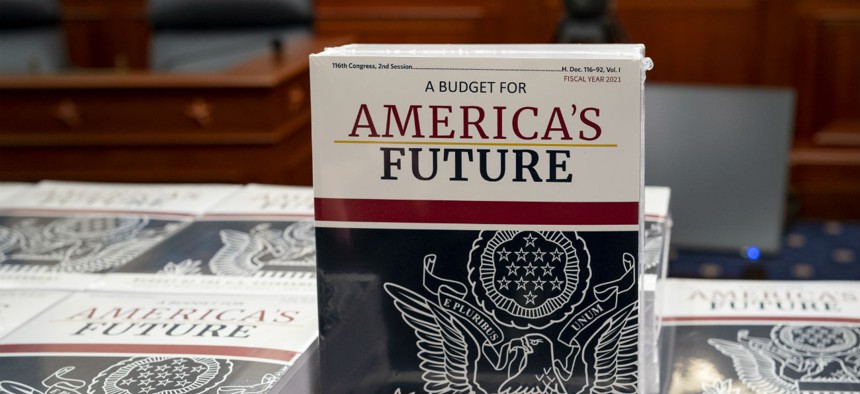
The White House budget proposal contains a number of proposals previously rejected by Congress. J.Scott Applewhite/AP
Trump’s Fiscal 2021 Budget Seeks to ‘Resize’ the Bureaucracy
Among other things, the White House wants to rein in “improper end-of-year spending” by agencies.
On Monday afternoon, President Trump sent Congress a $4.8 trillion budget request for fiscal 2021 that seeks to “resize” the federal government by eliminating what the administration views as duplicative and wasteful programs and focusing on core security priorities.
The budget request includes a number of proposals Congress has previously rejected, such as significant cuts to the social safety net, foreign aid and environmental programs, as well as some federal workforce hiring and firing reforms and changes to federal retirement the administration has tried to implement previously with mixed success.
Margaret Weichert, deputy director for management at the Office of Management and Budget, told reporters on Monday that the budget reflects “the core elements of the president’s management agenda” and is a “continuation of what we’ve attempted to do over the last couple of years around the workforce.” While the administration will continue to press for moving federal employees to a pay-for-performance system and employee training and reskilling, “not surprisingly, in year four of an administration there’s not a lot of net new ideas,” she said.
In budget documents, the administration maintains that over the last century the federal bureaucracy, with its two million civilian employees and millions more paid through contracts and grants, has “overrun [its] Constitutional guardrails”:
“Taxpayers have repeatedly watched the Federal Government respond to any problem with the creation of new agencies, new programs, and new spending initiatives, instead of reorganizing, or repurposing what is already available within the vast bureaucracy. As a result, there are hundreds of programs in the Federal Government that have outlived their mission, duplicate efforts, or operate below peak efficiencies because of fragmented responsibilities between agencies.”
Overall, the Trump administration would increase military spending by 0.3% (to $740.5 billion) and decrease non-defense spending by 5% (to $590 billion,), which is below the budget cap Congress and the White House agreed to last summer.
Agencies where spending would grow under the president’s budget request include NASA (12%), the Veterans Affairs Department (13%), the National Nuclear Security Administration (19%) and the Homeland Security Department (3%).
But the administration would offset those increases with steep cuts in other agencies. Foreign aid would be slashed by 21%, the Environmental Protection Agency by 26%, Housing and Urban Development by 15%, the Centers for Disease Control and Prevention by 9%, although the administration would preserve $4.3 billion to fight infectious diseases as the coronavirus raises fears of a global pandemic. The White House would cut the Commerce Department by 37%, but attributes the decline to the completion of the census.
To reduce unnecessary spending across government the administration is proposing a number of specific things:
- Doubling down on efforts to end improper payments. The administration claims this costs taxpayers $70 billion per year. While agencies have made progress in addressing payment errors, the administration wants to streamline reporting requirements to reduce the agencies’ burden, clarify compliance requirements, and improve access to data on payment accuracy, among other things.
- Augmenting oversight of agencies’ expenditures on travel, conferences, marketing, subscriptions, entertainment and refreshments to root out potentially wasteful spending.
- Continuing to implement category management acquisition practices to coordinate bulk purchases of common goods and services. This is essential to deliver “more responsible, more agile, and efficient government,” according to Michael Wooten, the federal procurement policy administrator. The administration maintains that it has saved taxpayers $27 billion through category management since 2017 by eliminating 31,000 duplicative contracts. It is on track to achieve $36 billion by the end of fiscal 2020, Wooten said.
- Curbing “last-minute improper spending” by agencies at the end of the fiscal year. The budget cited a report from the nonprofit watchdog Open The Books, which advocates for transparency in government spending, that found that 67 agencies spent $97 billion during the last month of fiscal 2018, which was up by 39% from fiscal 2015. The administration noted that "misaligned incentives in the budgeting process" are to blame, and said it would more closely scrutinize such outlays in the future.
No president’s budget proposal survives Congress intact, and Trump’s will likely undergo major revisions.
Rep. Nina Lowey, D-N.Y, chairwoman of the House Appropriations Committee, said, “The president’s latest budget is a disastrous repeat of the misplaced priorities and callous cuts he has pursued unsuccessfully in past requests.”
Meanwhile, Republicans lauded the administration's vision.“We've got to get serious about tackling government waste and this budget does that,” tweeted Rep. Ted Budd, R-N.C.







